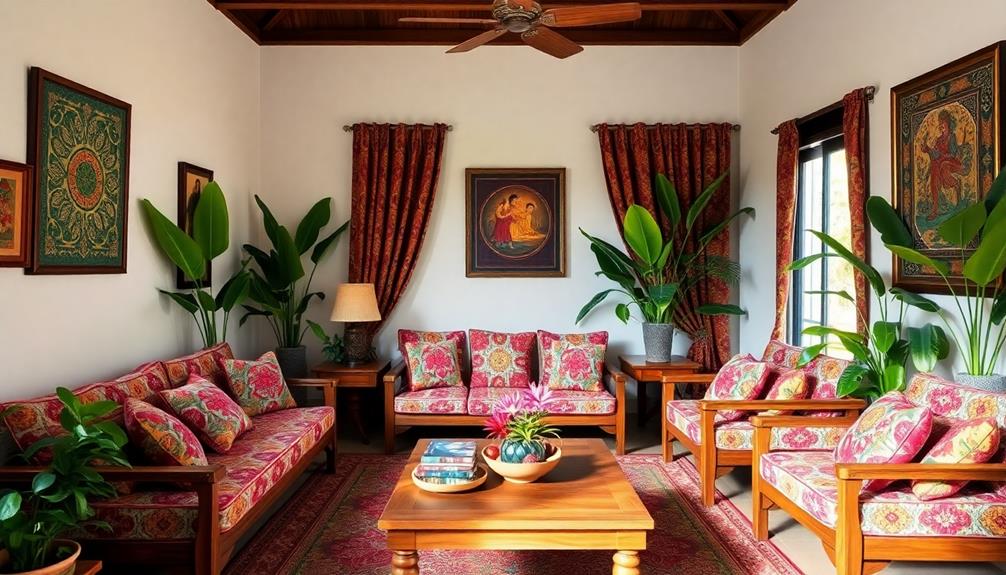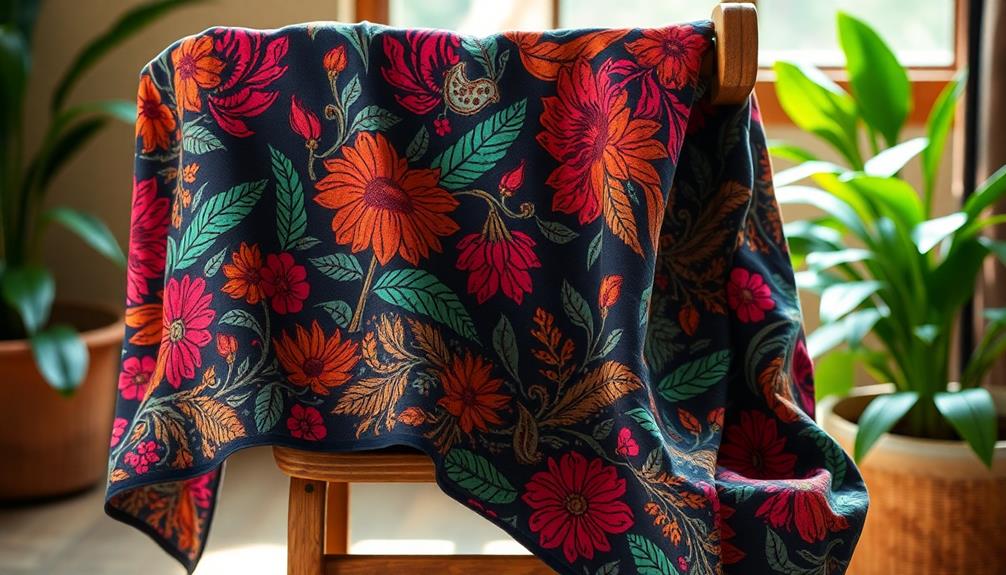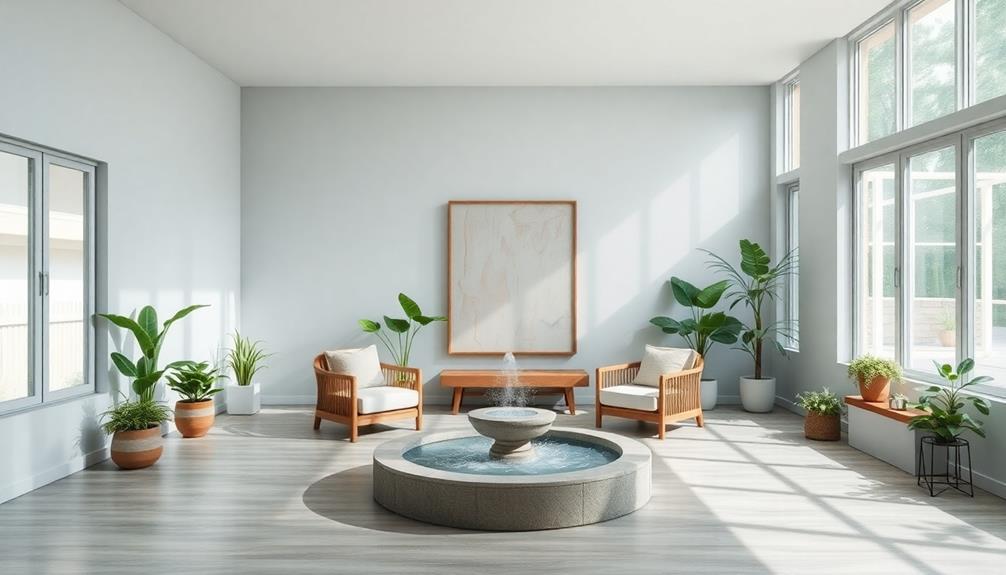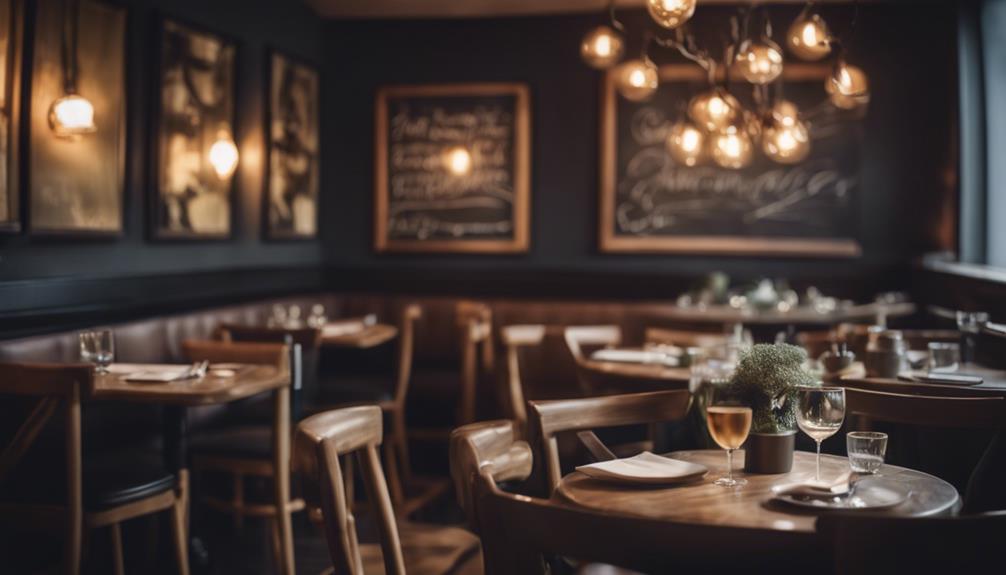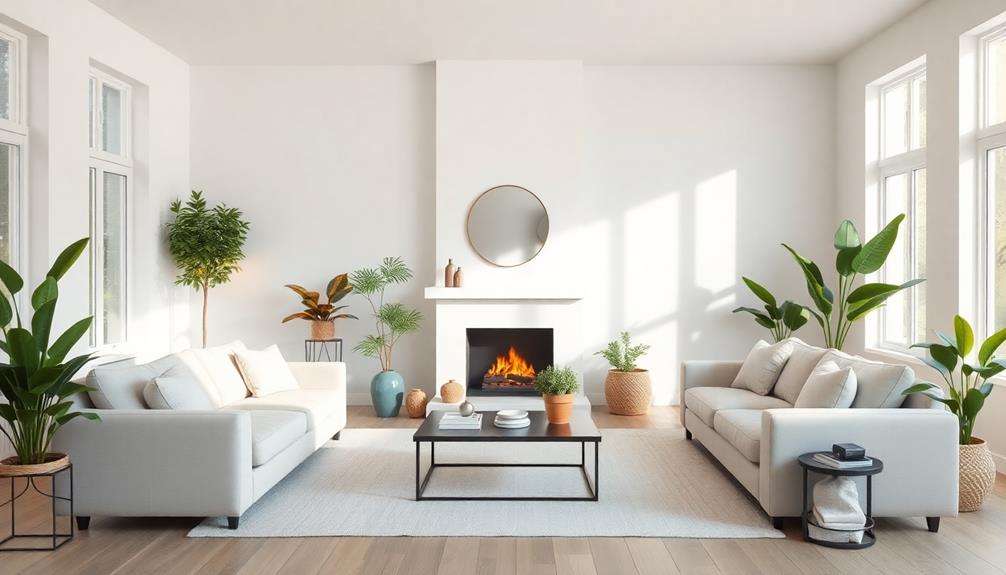Batik patterns are taking over the world of interior design because they bring vibrant colors and unique storytelling into your space. These handmade textiles, created through a traditional wax-resist dyeing technique, enhance any room with their charm and heritage. They fit seamlessly into various styles, from bohemian to minimalist, making them incredibly versatile. Plus, their cultural significance adds depth, reflecting local flora and fauna. As you experiment with batik in your décor—like accent pillows or wall art—you'll find endless possibilities for personalization. Discover more about how to effectively showcase these stunning patterns in your home.
Key Takeaways
- Batik patterns offer unique charm and vibrancy, enhancing interior spaces with their handmade aesthetic and rich narratives.
- Their versatility allows seamless integration into various design styles, from bohemian to minimalist, appealing to diverse tastes.
- Recognized by UNESCO, batik promotes sustainable practices and supports local artisans, adding cultural significance to modern interiors.
- The intricate storytelling and traditional motifs of batik resonate with contemporary design trends, making them desirable focal points.
- Batik textiles are increasingly used in upholstery and decor, providing opportunities for bold and personalized design choices.
The Allure of Batik Patterns
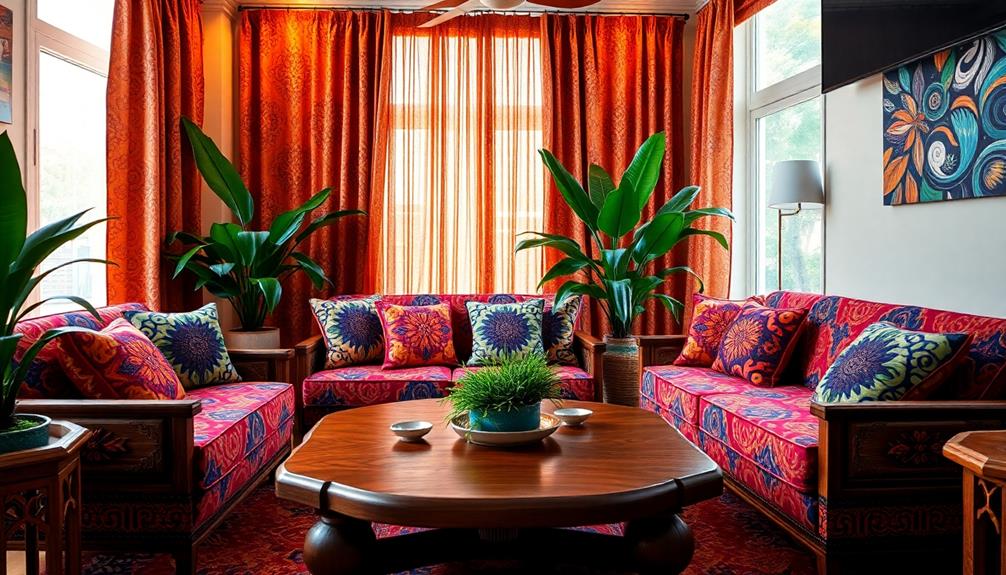
In recent years, batik patterns have captured the attention of interior designers and homeowners alike. These intricate designs, created through the traditional wax-resist dyeing technique, offer a unique handmade aesthetic that instantly elevates any space. With their vibrant colors and rich narratives, batik patterns serve as striking focal points, whether used in accent pieces or large installations.
Additionally, similar to the rich Indonesian cultural heritage reflected in decorative masks, batik patterns are an embodiment of traditional craftsmanship that enriches any decor.
Their versatility is one of batik's most appealing aspects. You can effortlessly blend these patterns into various design styles, from bohemian and eclectic to minimalist aesthetics, making them suitable for any room in your home.
As contemporary interiors evolve, the demand for artisan-made products continues to grow, and batik fits perfectly into this trend.
Moreover, the cultural significance of batik, recognized by UNESCO as an Intangible Cultural Heritage, adds depth and meaning to your decor. By incorporating batik patterns, you're not just enhancing your space; you're embracing sustainable design practices and supporting the artisans behind these beautiful creations.
Ultimately, batik patterns enrich your home with their vibrant colors and storytelling potential, making them an irresistible choice for any interior design enthusiast.
Cultural Significance of Batik

While many admire batik for its stunning visuals, its cultural significance runs much deeper, reflecting the rich heritage of Indonesia. Originating from Java, batik patterns symbolize social status and identity through intricate motifs and vibrant colors. Recognized by UNESCO in 2009 as a Masterpiece of Oral and Intangible Heritage, batik showcases the craftsmanship of diverse ethnic groups.
Here's a snapshot of some key aspects of batik's cultural significance:
| Aspect | Meaning | Example Motif |
|---|---|---|
| Social Status | Signifies rank and class | Sido Luhur (Honor) |
| Storytelling | Preserves local narratives | Parang (Continuity) |
| Craftsmanship | Handmade artistry | Traditional Batik |
| Cultural Heritage | Reflects local flora and fauna | Various Regional Styles |
| Design Trends | Inspires modern interiors | Contemporary Adaptations |
Traditional batik designs carry specific meanings, making them essential for storytelling, ceremonial attire, and cultural celebrations. In a world increasingly drawn to meaningful decor, the allure of batik patterns lies not just in their beauty, but in the stories they tell and the cultural heritage they represent.
Techniques Behind Batik Creation

Batik creation is a fascinating process that combines artistry with skilled craftsmanship. At its core, the batik process involves a wax-resist dyeing technique, often celebrated in Indonesian decorative pillows for their vibrant colors and intricate patterns.
You start by applying hot wax to fabric, which creates intricate patterns that resist dye during the coloring stage. There are three primary techniques: Batik Tulis, Batik Cap, and Batik Lukis.
Batik Tulis is hand-drawn using a canting tool, allowing batik artists to control the wax flow for detailed, unique designs. In contrast, Batik Cap employs copper stamps to apply patterns more quickly, making it ideal for mass production.
Finally, Batik Lukis involves painted designs, offering artists the freedom to express themselves further.
Throughout the batik process, multiple rounds of dying occur, often using traditional dyes derived from plants and minerals. This method creates vibrant colors and guarantees the longevity of the batik fabrics.
After the final dyeing, the fabric is dried and soaked in color-fixing solutions, solidifying those beautiful patterns. The result is a stunning array of textiles that showcase the rich heritage and skill of batik creation.
Modern Applications in Interior Design
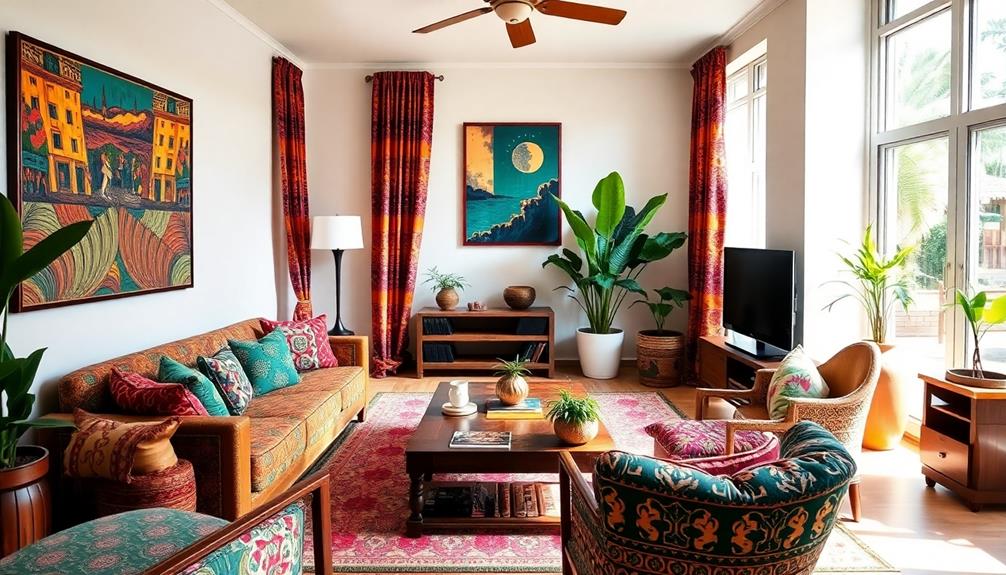
As designers explore innovative ways to elevate interior spaces, batik fabrics have emerged as a vibrant choice that blends tradition with modern aesthetics. You'll find batik fabric making a statement in various elements of interior design, from bedding to upholstery. Its intricate patterns and vibrant color infuse contemporary environments with life and character, complementing styles like traditional Indonesian style home decor that emphasize harmony with nature.
This art form isn't just limited to smaller items; think floor-to-ceiling panels or stunning installations that serve as focal points in your home decor. Whether you lean toward a bohemian vibe or a luxurious setting, batik's versatility allows it to blend seamlessly into any design style.
The global interest in batik has sparked collaborations with international brands, enhancing its visibility in high-end markets. Plus, as you consider sustainable fashion, using batik supports local artisans and promotes traditional craftsmanship, ensuring that your choices are both stylish and ethical.
With floral imagery and intricate patterns at the forefront, batik fabrics not only tell a story of heritage but also provide a modern application that resonates with today's design sensibilities.
Embrace the charm of batik and transform your space into a vibrant tapestry of culture and creativity.
Practical Tips for Using Batik
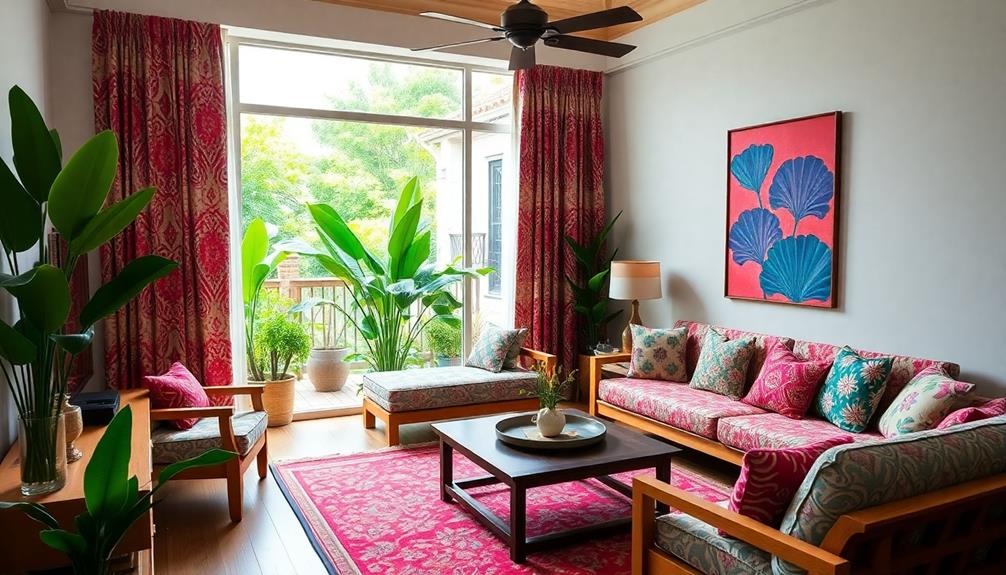
When it comes to incorporating batik into your interior design, thoughtful choices can make all the difference. Batik's vibrant patterns and rich cultural heritage can add a unique character that elevates your space.
Additionally, considering the use of traditional artistry found in Indonesian decor masks can further enhance the cultural depth of your design. Here are some practical tips to help you use batik effectively:
- Choose authentic batik fabrics that reflect traditional craftsmanship while staying budget-friendly.
- Balance vibrant batik patterns with neutral or solid-colored elements to maintain elegance and avoid overwhelming your room.
- Experiment with color: Use muted batik for a subtle look, or go bold with vibrant hues for a striking focal point.
- Incorporate batik in accent pieces like throw pillows, curtains, and wall art to enhance visual interest while keeping your design cohesive.
- Utilize batik textiles in various forms, such as upholstery and table linens, to personalize your space and connect with family histories.
Frequently Asked Questions
Why Is Batik Declining?
Batik's declining due to mass-produced textiles overshadowing its unique craftsmanship. Younger generations aren't learning traditional techniques, while synthetic dyes and cheaper fabrics dominate the market, leading to a loss of authenticity and cultural significance.
Why Is Batik so Special?
Batik's like a vibrant tapestry, weaving stories through intricate patterns. Its cultural significance, rich history, and unique artistry make it special. You'll find its beauty resonates deeply, transforming spaces with warmth and meaning.
What Is the Importance of Batik Making?
Batik making's importance lies in its cultural heritage, intricate craftsmanship, and storytelling. You appreciate its rich traditions, support local artisans, and recognize how it preserves identity and community values while contributing to economies through sustainable practices.
Which Country Block Printed Batik?
You'll find that block printed batik primarily originates from Indonesia, especially Java. This technique, refined over centuries, also influences styles in India, showcasing unique local traditions. It's a fascinating blend of culture and craftsmanship.
Conclusion
So, if you're tired of dull, lifeless walls and want to impress your friends with your "worldly" taste, batik patterns are your ticket to instant sophistication. Forget about minimalism; who needs empty spaces when you can drown in an explosion of colors and history? Just remember, if someone questions your choice, you can always say it's a "cultural statement." After all, nothing says "I'm cultured" quite like a wall that looks like a kaleidoscope threw up!

